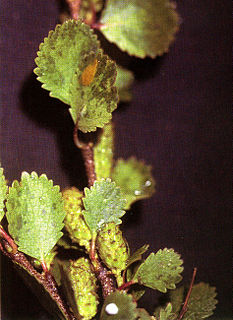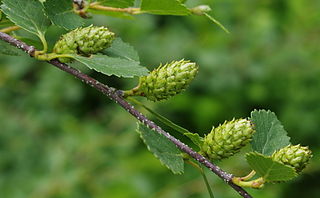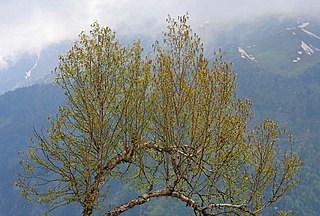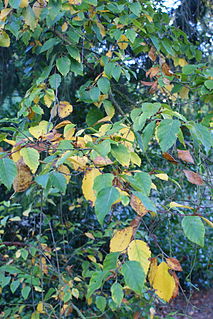
A birch is a thin-leaved deciduous hardwood tree of the genus Betula, in the family Betulaceae, which also includes alders, hazels, and hornbeams. It is closely related to the beech-oak family Fagaceae. The genus Betula contains 30 to 60 known taxa of which 11 are on the IUCN 2011 Red List of Threatened Species. They are a typically rather short-lived pioneer species widespread in the Northern Hemisphere, particularly in northern areas of temperate climates and in boreal climates.

Betula pendula, commonly known as silver birch, warty birch, European white birch, or East Asian white birch, is a species of tree in the family Betulaceae, native to Europe and parts of Asia, though in southern Europe, it is only found at higher altitudes. Its range extends into Siberia, China, and southwest Asia in the mountains of northern Turkey, the Caucasus, and northern Iran. It has been introduced into North America, where it is known as the European white birch or weeping birch and is considered invasive in some states in the United States and parts of Canada. The tree can also be found in more temperate regions of Australia.

Betula pubescens, commonly known as downy birch and also as moor birch, white birch, European white birch or hairy birch, is a species of deciduous tree, native and abundant throughout northern Europe and northern Asia, growing farther north than any other broadleaf tree. It is closely related to, and often confused with, the silver birch, but grows in wetter places with heavier soils and poorer drainage; smaller trees can also be confused with the dwarf birch.

Betula nigra, the black birch, river birch or water birch, is a species of birch native to the Eastern United States from New Hampshire west to southern Minnesota, and south to northern Florida and west to Texas. It is one of the few heat-tolerant birches in a family of mostly cold-weather trees which do not thrive in USDA Zone 6 and up. B. nigra commonly occurs in floodplains and swamps.

Betula papyrifera is a short-lived species of birch native to northern North America. Paper birch is named for the tree's thin white bark, which often peels in paper like layers from the trunk. Paper birch is often one of the first species to colonize a burned area within the northern latitudes, and is an important species for moose browsing. The wood is often used for pulpwood and firewood.

Betula alleghaniensis, the yellow birch, golden birch, or swamp birch, is a large tree and an important lumber species of birch native to northeastern North America. Its vernacular names refer to the golden color of the tree's bark. In the past the species name was Betula lutea.

Betula lenta is a species of birch native to eastern North America, from southern Maine west to southernmost Ontario, and south in the Appalachian Mountains to northern Georgia.

Betula nana, the dwarf birch, is a species of birch in the family Betulaceae, found mainly in the tundra of the Arctic region.

Betula glandulosa, the American dwarf birch, also known as resin birch or shrub birch, is a species of birch native to North America.

Betula populifolia is a deciduous tree native to eastern North America.

Betula pumila is a deciduous shrub native to North America. Bog birch occurs over a vast area of northern North America, from Yukon in the west to New England in the east and all the way to Washington and Oregon, inhabiting swamps and riparian zones in the boreal forests.

Betula cordifolia, the mountain paper birch is a birch species native to Eastern Canada and the Northeastern United States. Until recently it was considered a variety of Betula papyrifera, with which it shares many characteristics, and it was classified as B. papyrifera var. cordifolia (Regel) Fern.

Betula utilis, the Himalayan birch, is a deciduous tree native to the Western Himalayas, growing at elevations up to 4,500 m (14,800 ft). The Latin specific epithet utilis means "useful", and refers to the many uses of the different parts of the tree. The white, paper-like bark was used in ancient times for writing Sanskrit scriptures and texts. It is still used as paper for the writing of sacred mantras, with the bark placed in an amulet and worn for protection. Selected varieties are used for landscaping throughout the world, even while some areas of its native habitat are being lost due to overuse of the tree for firewood.

Betula dahurica, Dahurian birch, or Asian black birch, is a species of birch which is native to China, Japan, Korea, eastern Mongolia, and Russian Far East. It was introduced to the United Kingdom and also grows at the Arnold Arboretum in Boston. In Japan, it usually grows in Nobeyama in Nagano Prefecture in the island of Honshu where it is considered to be endangered. Small population of them can also be found on Hokkaido and Kuril Islands.

Betula humilis, known in English as the shrubby birch, is a species of birch that can be found in Europe and Asia. The species has ovate leaves that are 1.2–3.5 centimetres (0.47–1.38 in) long and is related to Betula fruticosa.

Betula fruticosa, commonly known as dwarf bog birch, is a species of dwarf birch that grows in central and eastern Europe and Siberia and Mongolia on elevation of 600–1,100 metres (2,000–3,600 ft) in forests, streambanks, and swamps.

Betula alnoides is a species of birch that can be found in natural condition of such countries as Bangladesh, Bhutan, Cambodia, China, India, Laos, Myanmar, Nepal, Thailand and Vietnam at an elevation of 300–2,100 metres (980–6,890 ft) and higher in some cases. The southernmost of all known birch species, whose natural range reaches approximately 12° N in Cardamom Mountains, Cambodia.

Betula chinensis, commonly known as dwarf small-leaf birch, is a species of birch that can be found in China and Korea on the elevation of 700–3,000 metres (2,300–9,800 ft).

Betula chichibuensis, commonly known as Chichibu birch, is a species of birch native exclusively to limestone outcrops in the Okuchichibu and Kitakami Mountains of central and northeast Honshu, Japan. The tree is rated as Critically Endangered on the IUCN Red List due to its extreme rarity and limited range.




















